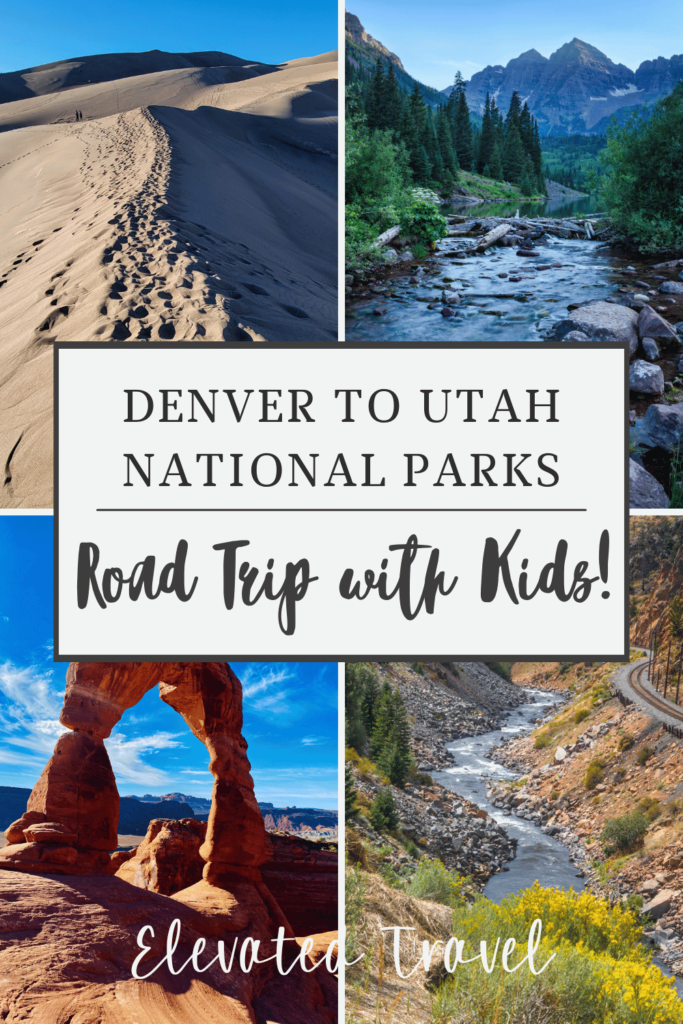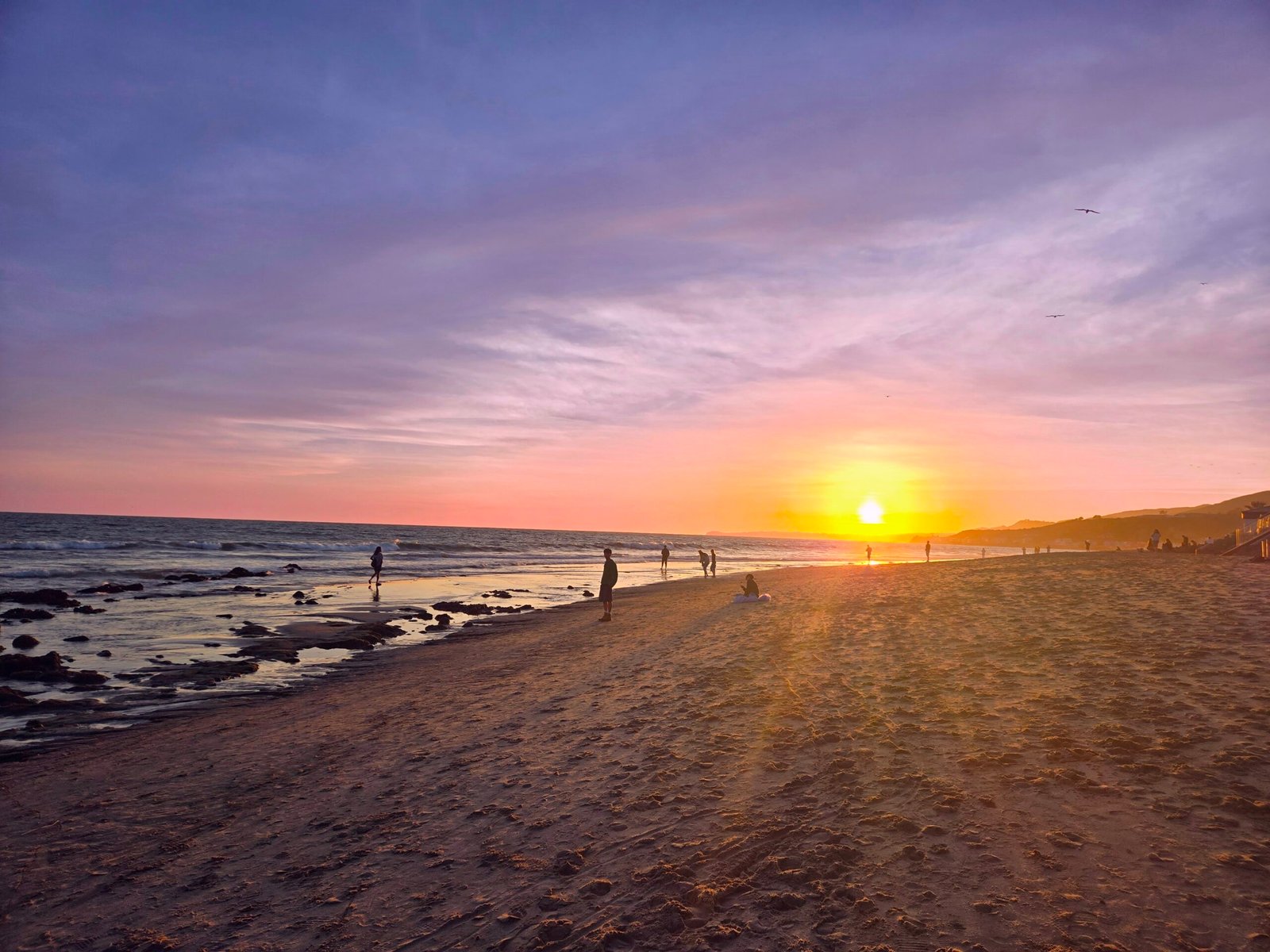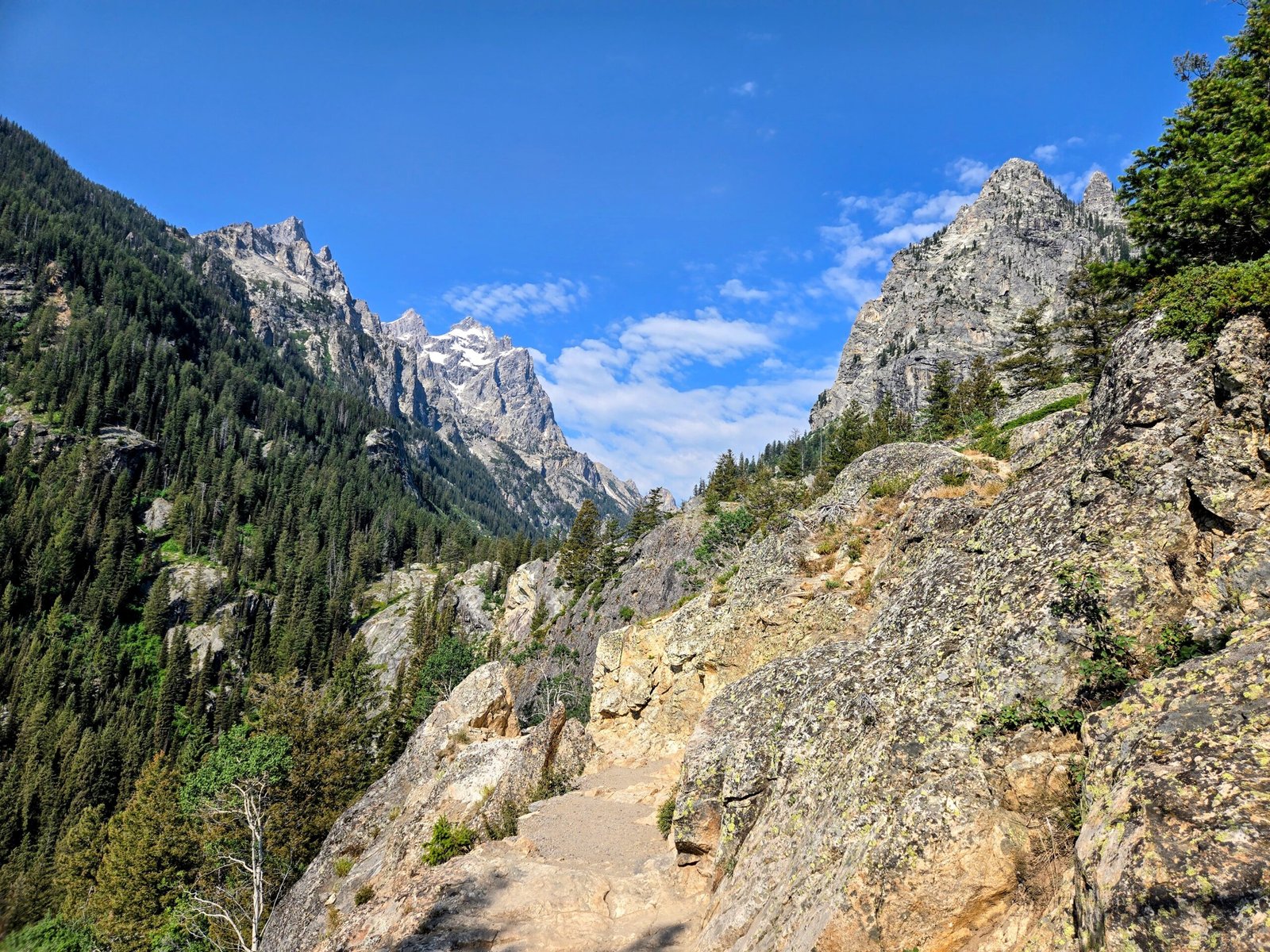If you’ve been on my blog before, it is no secret that I absolutely adore Colorado and Utah (and if you’re new here, hi! I’m so happy you’re here!).
My family had the privilege of living in Colorado for an entire summer back in 2022, and in the southwest corner of Wyoming within driving distance of Moab in 2024. This was pure mountain hiking and exploring bliss for us. If you love the mountains and alpine lakes you are in for such a treat.
Believe me when I say that this is one of the most incredible road trips you can take in the US. If you’re reading this article because you’re planning a Colorado-Utah National Park trip just know that I am very jealous of you right now. It is a bucket list vacation and you are going to have an incredible time!
I know that planning a trip this large can be intimidating, and you want to make sure you see all of the incredible things there are to see in this area. Throw kids into the mix and it gets extra stressful.
But don’t worry, I got you! Follow this guide and you will have the best Denver to Utah National Parks road trip you could dream of!

Table of Contents
Best Time for a Colorado to Utah National Parks Road Trip
For this bucket list itinerary that I am going to share with you, I recommend taking this trip between Memorial Day and Labor Day. This is due to the high elevation of the mountains in Colorado and the unpredictability of the snow. Additionally, this itinerary requires driving Trail Ridge Road, the highest continuous paved road in North America. The National Park Service (NPS) designates when it is safe to open this road, and it is typically between these dates.
Like this article? Pin it for later!
Map of Denver to Utah National Parks Road Trip
How Much Time is Needed For This Itinerary?
You will notice I don’t have specific days numbered for each destination. That is because we all have different priorities, and this itinerary is meant to be used as a helpful guide rather than an exact itinerary. That said, this guide has travelers driving approximately 1,400 miles round-trip, so I would strongly recommend at least 14 days to complete the full loop. If you don’t have that much time, you could remove the Utah National Parks from your itinerary. Alternatively, you could remove Mesa Verde National Park and Great Sand Dunes National Park and opt to head east after Black Canyon of the Gunnison National Park to return to Denver.

Denver: A Vibrant Starting Point
This guide begins with visitors flying into the Mile High City: the city that bridges the energy of urban life with the call of the wilderness.
After arriving at Denver International Airport, visitors can pick up their rental car and explore some of the city’s highlights. The Denver Art Museum is a great introduction to the creative energy of Colorado, while a stroll along Main Street gives visitors the opportunity to stretch their legs and soak in the culture. Denver is packed full of breweries and distilleries and other places to unwind before starting your big trip.
I think it is important to stay the night here after your flight before starting your drive towards Estes Park, and this is for two reasons. One, you will want to rest and get an early start for the entrance gate at Rocky Mountain National Park. The lines get incredibly long so you will want to arrive early. Two, this will give you a night to acclimate to the high elevation to hopefully avoid elevation sickness.
When it’s time to leave Denver, head northwest on US-36 toward Estes Park, where the Rocky Mountains loom in the distance. The scenic drive takes just under two hours and winds through open plains before transitioning into a winding mountain road.

Estes Park: The Gateway to the Rocky Mountains
Nestled against the towering Rocky Mountains, Estes Park is a welcoming town full of charm and stunning vistas. The main attraction here is the east park entrance to Rocky Mountain National Park. Estes Park is an incredible mountain escape full of things to do, such as ATV rentals, hiking, visiting wineries and breweries, shopping, Jeep tours, and more.
If you would like to spend some extra time in the eastern part of Rocky Mountain National Park with easy access to some of the popular hikes like Bear Lake, it would be a good idea to stay a night in Estes Park. There are some nice accommodations with spas that will give you the complete mountain lodge relaxing experience before continuing your road trip.
Booking a Denver to Utah National Parks trip? Book your accommodations through me! I will get you the best deal on your hotels, and may even get you perks like early check-in, room upgrades, spa credit, and more. Submit a travel inquiry for a quote!
Get better prices, perks, and customer service than you would booking through an online search engine.
Submit a Travel Inquiry


Rocky Mountain National Park
Rocky Mountain National Park is incredibly beautiful, from the stunning mountain passes and vistas to the alpine lakes. It is teeming with wildlife, and it is likely that you will spot moose, elk, bighorn sheep, or black bear (there are no grizzly bears in Rocky Mountain National Park).
Due to the park’s popularity, it now operates on a timed entry system during the busy season. For 2025, timed entry passes are needed for visiting the park between May 23rd to October 20th. For more information about the timed entry system, including how and when to obtain the timed entry passes, visit the National Park Service site here Timed Entry Permit System – Rocky Mountain National Park (U.S. National Park Service).
As I mentioned earlier, this guide has you taking Trail Ridge Road through Rocky Mountain National Park. Trail Ridge Road (highway 34) is 48 miles long and stretches the length of the park between Estes Park and Grand Lake. 11 miles of the road is at an elevation of 11,500 feet or higher, and the highest point is at 12,183 feet above sea level. This road is both thrilling and terrifying (if you ask me). There are portions of the road at high elevation where there are sharp turns with no shoulder or guard rails. I would be lying if I said I wasn’t gripping my seat each time we drove it. But hey, it’s all part of the experience, right?
There are some stunning scenic pull-offs along Trail Ridge Road, and a visitor center and store and cafe combination near the midpoint of the road with a bathroom.
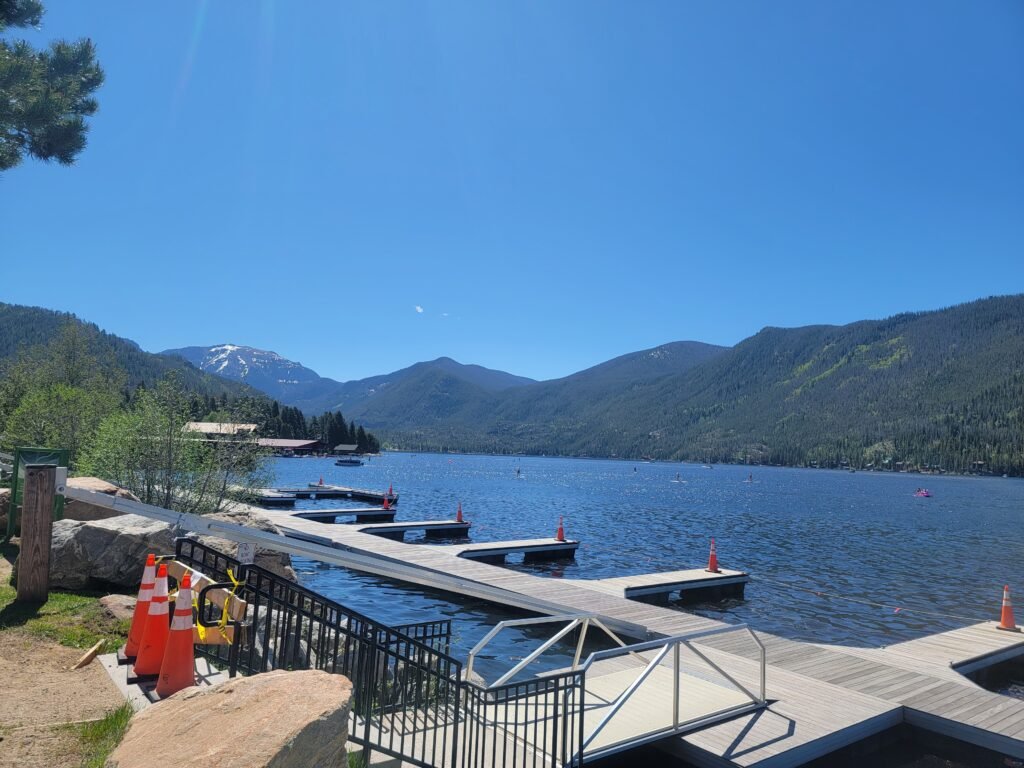
Grand Lake, Colorado
Descending from Trail Ridge Road, travelers arrive at Grand Lake, a quaint town that feels like a step back in time. This is the perfect place to stretch your legs with a walk along the lake’s edge or grab a meal with views of the water. If you would like to spend a day in Grand Lake, this is a nice, quiet town with a slow pace. There are a lot of small local businesses and shops, kayaking on Grand Lake, or a lovely park to let the kids play and have a picnic.
Your next stop, Grand Junction, is about 4 hours away. Your route takes you southwest along US-40 and I-70. The route passes through the breathtaking landscapes of Glenwood Canyon, where steep canyon walls rise dramatically on either side of the highway. Plan for a 4-hour drive that’s almost as rewarding as the destination itself.

Grand Junction and Colorado National Monument
Grand Junction serves as the gateway to Colorado’s western slope, a landscape rich with vineyards, mesas, and dramatic desert vistas. Just a short drive from town, Colorado National Monument offers scenic views of towering rock formations and expansive canyon walls. Colorado National Monument is underrated and is a quick, easy stop to add onto this itinerary.
When it’s time to move on, continue west on I-70 toward Moab, Utah. The journey takes about 2 hours, following the winding path of the Colorado River as it carves through the landscape.

Moab, Utah: Gateway to Utah National Parks
Moab is the ultimate base for exploring the two Utah National Parks in this guide, Arches and Canyonlands, and Dead Horse Point State Park. I recommend staying at least a couple nights in Moab to explore all there is to see in this area. There are some fantastic resorts in this area, and some even have waterslides and extra perks for kids. Use Moab as a homebase for exploring the following Moab attractions.
I do want to note that there are so many fantastic things to do in and around Moab that I’m not touching on in this article. Moab is a hub for adventure, offering endless activities like off-roading, mountain biking, and exploring its vibrant downtown. While there’s so much to experience in the area, this guide focuses specifically on the National and State Parks. Moab is incredible- there simply isn’t enough time to see and do it all!
For a guide to Moab with kids, check out this article: Moab with Kids: 3 Must-Visit Places Beyond Arches

Arches National Park
Arches National Park is just a short drive from town and features iconic natural sandstone arches like Delicate Arch and Mesa Arch. Arches is another very popular park and has also implemented a timed entry system like Rocky Mountain National Park has. If you are unable to secure a timed entry pass, you can enter the park before sunrise. With the summer heat, I believe this is the best way if you plan to do any hiking anyway. The heat during the summer months on the red rocks gets incredibly hot, so it’s best to get an early start.
Get more information on Arches National Park timed entry here Timed Entry Reservation – Arches National Park (U.S. National Park Service).

Canyonlands National Park
Canyonlands National Park is highly underrated in my opinion. This is the largest National Park in Utah, and is divided into 4 districts. The Island in the Sky District, which is the most visited and accessible district, is a 40-minute drive from Moab. Here, travelers can peer into canyons carved by the Green and Colorado Rivers, take easy walks to overlooks, or venture further into the wild on backcountry trails.
The Island in the Sky District is where you will find the iconic Mesa Arch. This is a relatively short, easy hike and simple to add onto any itinerary.
The remaining districts are:
The Needles: ideal for travelers seeking longer hikes and backcountry trails. It’s known for its colorful sandstone spires and features trails like Chesler Park Loop.
The Maze: remote and challenging to reach, catering to experienced adventurers.
The River District (Colorado and Green River): provides rafting and kayaking opportunities.
The park has minimal services, so you should pack plenty of water and snacks. When we travel to places like this with kids we always bring literal boxes of snacks and multiple gallons of water. It gives me mom anxiety to think we might run out.
A single entrance fee covers all districts, but they are not all interconnected—be prepared for long drives between areas if you plan to explore more than one.

Dead Horse Point State Park
The turn for Dead Horse Point State Park is on your route back to Moab from Canyonlands, so you’re kind of obligated to make a stop at this State Park.
Seriously, I think this is our favorite thing we did in Moab. It is absolutely worth a stop. We compared it to the Grand Canyon, only better.
It is a small park so you don’t need long to visit. There is just the main parking lot surrounded by 360° views. You can take a short walk to an incredible overlook with guardrails with the kids. There are plenty of spaces to get away from the crowd and have a picnic alone with the family, but you will need to be extremely cautious if you have little ones with you. Just keep them close.
Pro tip: If you have the opportunity to visit this park during sunset you need to do it. Sunset at Dead Horse Point State Park is one of the best I have ever seen.
The next stop on this guide is Black Canyon of the Gunnison National Park. It is about a 3-hour drive, and approximately 180 miles, to the south rim of the park from Moab.

Black Canyon of the Gunnison National Park
Black Canyon of the Gunnison National Park showcases some of the steepest cliffs and narrowest gorges in North America, carved over millions of years by the Gunnison River. The park has two main access points—the South Rim and the North Rim—each offering a different experience for travelers.
We didn’t have high expectations for this park, but it still resides in our Top 10 list to this day. It is so beautiful! We visited the South Rim. I love how easily accessible it is. You can take in most of the beauty of the park from the car, and opt to do some short hikes to overlooks for gorgeous photos if you’d like.
Please note if you are a nervous parent: there are no guardrails or fences at this park. It’s a free-for-all. We only had one kiddo when we visited this one and we kept him securely in our hiking backpack whenever we were outside of the vehicle.
Here is the link to our favorite kids hiking carrier I always recommend because it really is that good. It’s well worth the investment. We used the same one for both kids!
The South Rim is the most visited and accessible part of the park. It features a paved road leading to several stunning viewpoints, including Gunnison Point and Chasm View. Short trails like the Rim Rock Trail allow visitors to experience the canyon’s dramatic scenery without requiring strenuous effort. The South Rim Visitor Center provides helpful information about the park’s unique geology, and a campground is available nearby for a bargain option on lodging.
For a complete guide on camping with kids, check out Camping with Kids Checklist: Must-Have Outdoor Camping Gear for Kids.
The North Rim offers a quieter, more rugged experience. Though less developed, it provides equally impressive views, such as those from Exclamation Point, and is a great option for travelers seeking solitude. However, it is important to note that the North Rim has unpaved roads and fewer amenities.
Traveling between the two rims requires a two-hour drive, as there is no bridge crossing the canyon. Most people visit just the south rim, and you get the full experience of the park this way. Visitors should plan ahead and pack plenty of water and snacks, as services in the park are limited. We didn’t have any cell service in the park our entire visit.
Your next leg of the trip is incredible. The journey is even better than the destination in my opinion. Next, you’re headed to Mesa Verde National Park, and I highly recommend taking the slightly longer, scenic route. This means taking US-550 S, also known as the Million Dollar Highway scenic byway my friend!

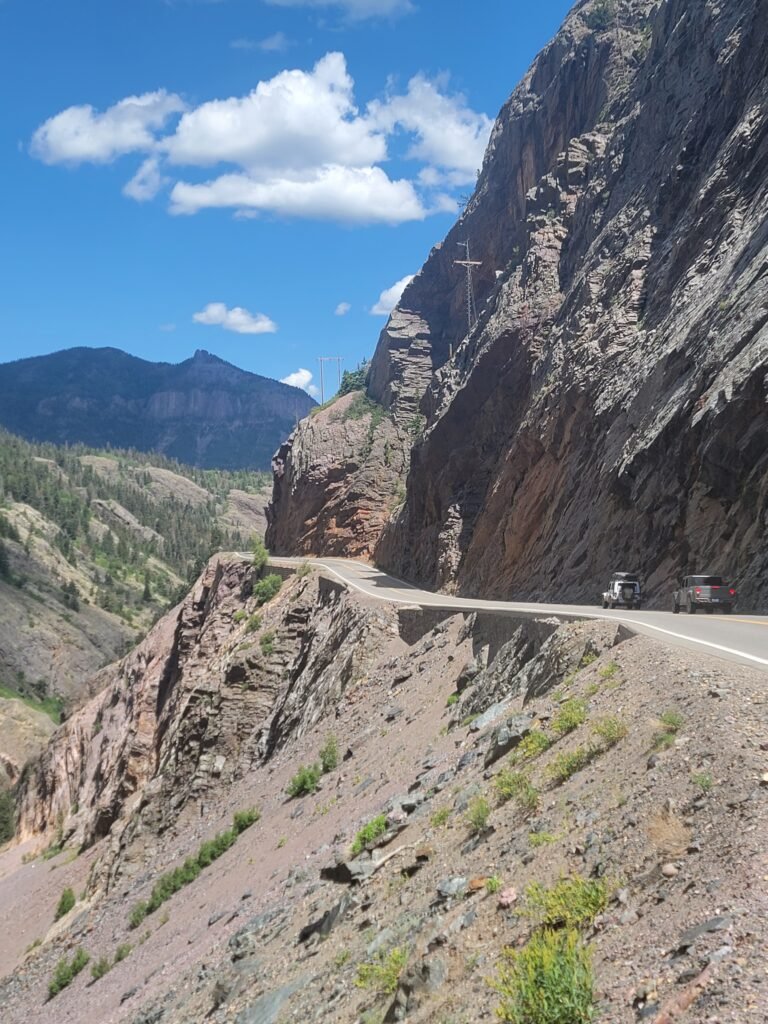
Ouray, Colorado and the Million Dollar Highway
Again, this is a National Park Guide, so I won’t get too in-depth here, but I would be doing a massive disservice if I didn’t talk about the incredible beauty that is Ouray and the Million Dollar Highway, also called the San Juan Skyway.
Situated deep within the San Juan Mountains, Ouray, Colorado is referred to as the “Switzerland of America” due to its absolutely stunning alpine scenery. Surrounded by towering peaks and deep canyons, this small town of less than 1,000 residents offers a picturesque setting that’s perfect for outdoor enthusiasts and those seeking a peaceful retreat.
Known for its natural hot springs, Ouray is an ideal spot to relax and unwind after a day of exploring. Visitors can enjoy soaking in the Ouray Hot Springs Pool or take a short hike to the Box Canyon Falls, a beautiful waterfall tucked into a narrow gorge. There are ample restaurants and shopping options right along Main Street making this a logical spot to stop for a night on your Colorado-Utah National Park road trip.
The Million Dollar Highway (U.S. Highway 550) between Ouray and Silverton offers some of America’s most stunning mountain views. As it winds through the San Juan Mountains, travelers are treated to panoramic vistas of rugged peaks, deep valleys, and cascading waterfalls. The road features sharp turns and narrow shoulders, so it’s important to drive with caution, but the breathtaking scenery places it high on many people’s bucket lists.


Mesa Verde National Park
The next park in this guide is Mesa Verde. Mesa Verde National Park is a UNESCO World Heritage Site that preserves the ancestral cliff dwellings of the Pueblo people. Personally, I am not much of a history buff, so I wasn’t overly thrilled by this park, but some people adore it. However, this park is much more scenic than I was expecting it to be. It offers a striking contrast to the snow-capped peaks visitors encounter earlier in the trip. While Colorado’s mountainous landscapes are known for their towering summits, Mesa Verde presents a more serene and arid beauty.
The park is famous for its ancient cliff dwellings, built by the Ancestral Puebloans over 800 years ago. Note that you must visit the dwellings with a tour guide in order to see the architecture up close. Tickets must be reserved in advance. To learn more and reserve your tickets you can visit the NPS site here Cliff Dwelling Tours – Mesa Verde National Park (U.S. National Park Service)
Your next part of the drive is about 4 hours and 30 minutes west to Great Sand Dunes National Park and Preserve.


Great Sand Dunes National Park and Preserve
Great Sand Dunes National Park is home to the tallest sand dunes in North America, rising up to 750 feet high against the backdrop of the Sangre de Cristo Mountains. The park’s striking contrast of golden sand and snow-capped peaks creates a surreal landscape that’s unlike any other in Colorado. Seriously, how cool is Colorado?
This is the coolest park in this guide to visit with kids. Since this guide has you visiting in the summer, you’ll want to be at Great Sand Dunes early in the morning to beat the heat. It gets extremely hot on the dunes. It goes without saying, but bring plenty of water. You absolutely have to take at least half a day to go sledding or sandboarding on the dunes. It is a ton of work repeatedly climbing back up the dunes, but it is a once-in-a-lifetime experience your kids (and you) will never forget!
You can rent sleds and boards right as you enter the park so don’t worry about packing them.
In the early part of the summer, around April-June, the Medano Creek runs through the park and adds an extra element of fun. The water runs between the dunes and the parking lot, giving visitors a spot to splash, relax, and cool down after playing in the hot sand.
For visitors looking to explore more of the natural beauty around Great Sand Dunes, the Zapata Falls Trail is a fantastic option. This short, 1.5-mile hike takes visitors through a scenic canyon to a stunning waterfall. The falls cascade down the cliffs, creating a cool, misty atmosphere that contrasts beautifully with the surrounding desert landscape. The trail is relatively easy, making it accessible for most visitors, and offers a peaceful escape from the vast sand dunes, with the chance to experience a different side of the park’s diverse environment. If you have a full day at Great Sand Dunes National Park this is a must-add to your itinerary.
Next, drive 2 hours and 30 minutes north on US interstate 25 to your final destination of this guide- Colorado Springs.
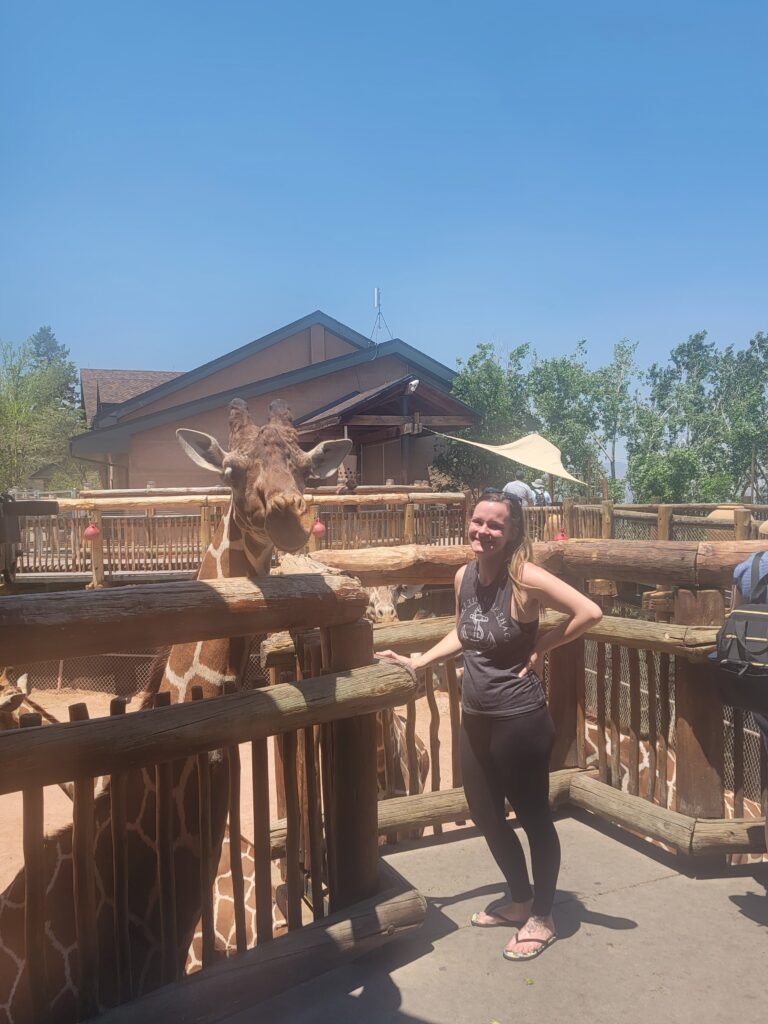
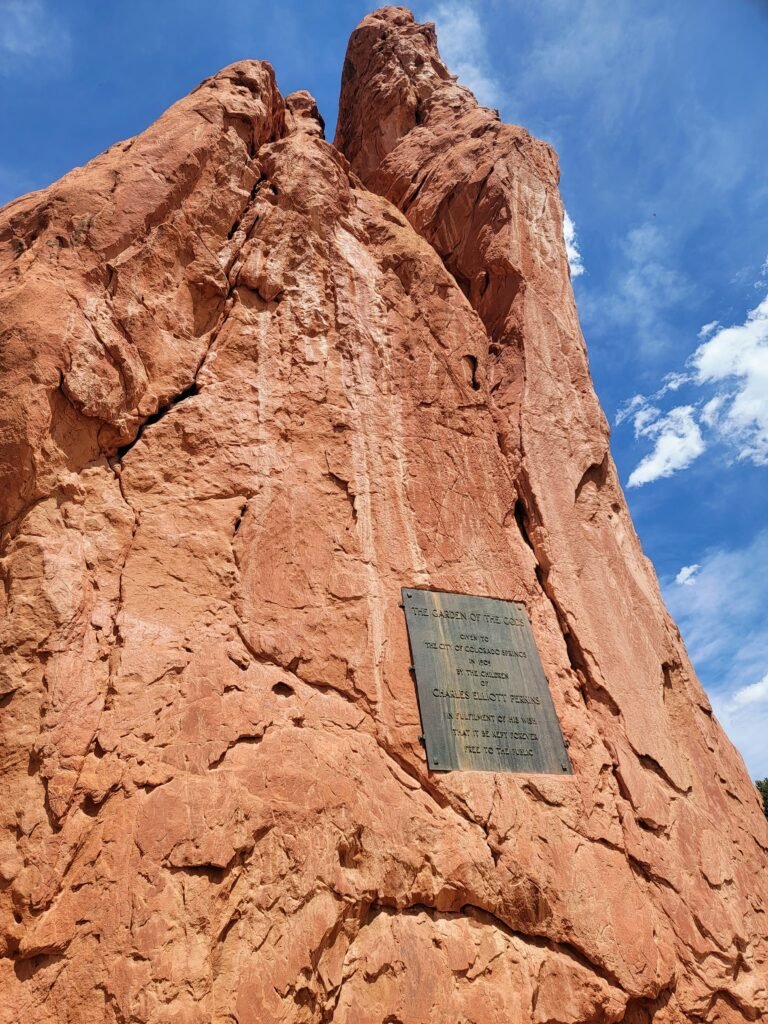
Colorado Springs, Colorado
There’s a ton to do in Colorado Springs making it a destination all on its own, but at the end of your road trip you’re probably starting to run on fumes (or maybe not! Good for you!)
There is so much to do in Colorado Springs, but I just want to touch on a few of the main attractions that I think are absolutely worth the time at the end of a long road trip, especially with kids.
Manitou Incline
The Manitou Incline is a challenge many visitors anticipate checking off of their bucket list, consisting of a steep, 2,000-foot climb over just under a mile. You’re looking at climbing around 2,700 steps. It’s a strenuous workout, but the reward is a stunning view of Colorado Springs and the surrounding mountains. The incline is popular, so be prepared for a crowd on busy days.
Cheyenne Mountain Zoo
Located on the side of Cheyenne Mountain, the Cheyenne Mountain Zoo is a treat for both kids and adults. When we were living near Denver we had many people tell us that we should visit the Cheyenne Mountain Zoo over the Denver Zoo because it is even better, and I agree! Home to over 750 animals, it’s one of the most interactive zoos in the country, featuring close encounters with animals like an opportunity to hand feed giraffes. Visitors can take a scenic chairlift ride or enjoy the zoo’s many exhibits, making it a great family-friendly stop.
Garden of the Gods
Garden of the Gods is a must-see park known for its striking red rock formations and spectacular views of Pikes Peak. The park offers a variety of hiking trails, ranging from easy walks to more challenging routes, all with incredible photo opportunities. I think this area is best experienced as a leisurely stroll along the paved boardwalks. Garden of the Gods is a very popular area, so get there early if you can before the parking lots fill up.
Pikes Peak
Pikes Peak, one of Colorado’s most iconic mountains, offers breathtaking views from its summit at over 14,000 feet. This is one of only two “14ers” (mountain peaks with an elevation above 14,000 feet elevation) in Colorado in which visitors can drive a vehicle to the top. Visitors ascend via Pikes Peak Highway, enjoying panoramic vistas of the surrounding landscape. Keep in mind that it takes around an hour to drive from the base to the summit, so ensure you have enough time at the end of your itinerary if you plan to drive Pikes Peak.
From Colorado Springs you have about a 1 hour and 30 minute drive back to Denver International Airport to conclude your ultimate Colorado and Utah summer road trip.
Do cell phones work in these National Parks?
For the most part, no. We have visited these areas with both Verizon and T-Mobile coverage and rarely had cell reception in any of these National or State Parks. Colorado and Utah have a lot of rugged, unpopulated land surrounding the parks.
What if I only have one week for our road trip?
I highly recommend two weeks to complete all of the incredible stops in this guide. If you aren’t able to take a full two week vacation, submit a travel inquiry. I will help you craft the most efficient itinerary that still allows you to see as much as possible in the time you have.
Planning a Denver to Utah National Parks road trip?
Consider booking your accommodations through me! I will get you the best deal on hotels that flow perfectly with your itinerary. I may also be able to secure perks like room upgrades, early check in, and spa credit. Submit a travel inquiry for a quote. Elevate your travel experience by booking your trip through a travel advisor instead of a third-party booking engine.
For more information about booking travel with me, see my Services page.
Have you been on a Denver to Utah National Parks road trip? Which part of the trip was your favorite? What questions do you have? Leave your comments below!
For more National Park inspiration, check out these articles:
Best Time to Visit Grand Teton National Park in 2025
Incredible Places to Visit in Death Valley National Park
An Incredible Day Trip to Channel Islands National Park With Kids
5 Best National Parks to Visit With Kids

